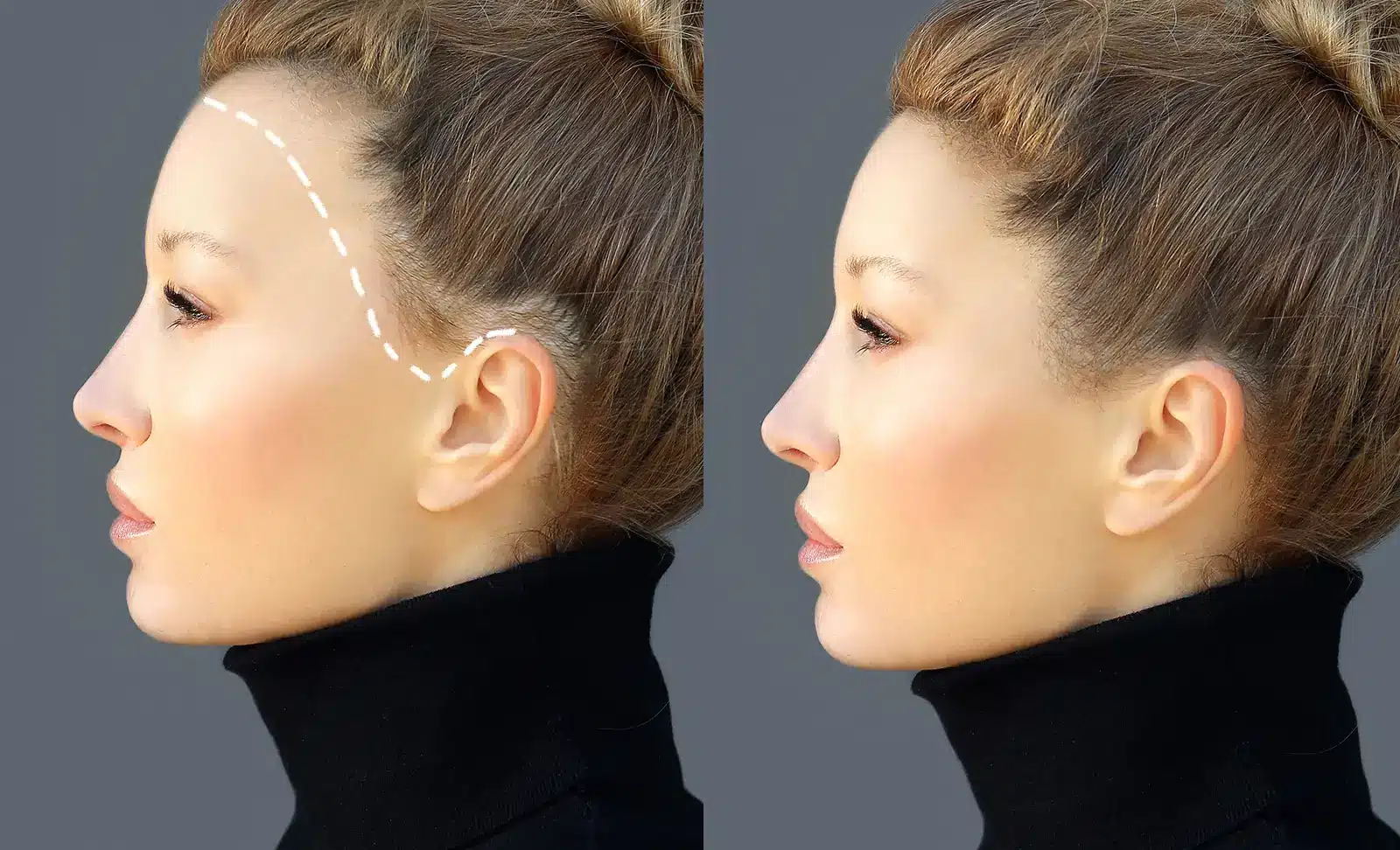Forehead transplant procedures are gaining increasing recognition in aesthetic medicine. This specialized surgical technique offers solutions for individuals seeking a more balanced facial appearance. The procedure addresses concerns related to the hairline’s position and shape. Patient satisfaction rates are notably high for this transformative intervention. It provides a permanent solution for those with a high or receding hairline. Clinical studies demonstrate significant improvements in facial harmony post-procedure. The precision involved in hairline repositioning is paramount for natural-looking outcomes. Expert surgeons meticulously plan each case based on individual facial anatomy. Forehead transplants utilize advanced surgical methods. These techniques ensure minimal scarring and optimal aesthetic results.
Table of Contents
How Do Hair Transplants Work for Forehead Reduction?
Hair transplant procedures represent a revolutionary approach to addressing high forehead concerns in women. The woman forehead hair transplant technique involves strategically relocating healthy hair follicles from donor areas to create a more proportionate facial appearance. This method has gained considerable recognition among patients seeking natural-looking results without the invasive nature of traditional surgical forehead reduction.
The hairline lowering transplant procedure utilises advanced microsurgical techniques to achieve precise hairline positioning. Surgeons carefully design the new hairline to complement individual facial features whilst maintaining natural hair growth patterns. Our experience demonstrates that forehead hair transplant female procedures require meticulous attention to hair direction, density, and angle placement to ensure seamless integration with existing hair.
During a hair transplant to lower hairline procedure, the process involves several core techniques that determine successful outcomes:
- Follicular Unit Extraction (FUE) method extracts individual hair follicles from occipital and parietal regions using specialised micro-punches
- Follicular Unit Transplantation (FUT) involves harvesting a strip of hair-bearing tissue from the donor area for maximum graft yield
- Direct Hair Implantation (DHI) technique enables simultaneous extraction and implantation using precise implanter devices
- Sapphire FUE utilises sapphire blades for creating recipient sites with minimal trauma and enhanced healing
- Robotic-assisted extraction employs ARTAS technology for consistent graft quality and reduced procedure time
The hair transplant for smaller forehead approach requires careful calculation of graft distribution across the treatment area. Surgeons typically transplant 2,000 to 3,500 grafts depending on the desired hairline advancement and individual scalp characteristics. The hair transplant for high hairline technique involves creating a natural temporal recession pattern to avoid an artificial straight-line appearance.
High forehead female hair transplant procedures demonstrate exceptional success rates when performed by experienced practitioners. The female hairline lowering hair transplant technique accounts for hormonal influences on hair growth patterns and incorporates these considerations into the surgical planning phase. Our clinical observations indicate that women achieve optimal results when the new hairline is positioned 6-8 centimetres above the eyebrow level.
Following the hair transplant to reduce forehead size procedure, patients experience a structured recovery timeline with specific milestones:
- Initial healing phase (Days 1-7) involves gentle cleansing routines and prescribed antibiotic protocols to prevent infection
- Scab formation period (Days 5-10) requires careful adherence to post-operative instructions whilst avoiding physical trauma to transplanted areas
- Shock loss phase (Weeks 2-4) represents normal follicle adjustment where transplanted hairs temporarily shed before entering growth cycles
- Early growth stage (Months 3-6) marks the beginning of visible hair emergence from transplanted follicles with gradual density improvement
- Maturation period (Months 6-12) delivers progressive hair thickening and length development reaching full cosmetic results
The big forehead hair transplant technique addresses proportional facial harmony through strategic graft placement. Modern approaches to hair transplant for big forehead women incorporate advanced imaging technology to preview potential outcomes before surgery. The big forehead transplant procedure requires comprehensive donor area assessment to ensure sufficient follicular reserves for achieving desired coverage.
Hair transplant for large forehead cases often benefit from staged procedures to maximise density whilst preserving donor resources. The hair transplant to make forehead smaller technique involves creating graduated density patterns that replicate natural hairline characteristics. Surgeons utilise single-hair grafts along the anterior hairline border with progressively denser multi-hair units positioned posteriorly.
Recovery expectations include complete healing within 10-14 days and initial hair growth visible after 3-4 months. The transplanted follicles establish permanent roots within the recipient area, ensuring long-lasting results that grow naturally with existing hair. Patients typically achieve 90-95% graft survival rates when following proper post-operative care protocols and maintaining realistic expectations throughout the recovery process. With this level of success, many patients who are interested in forehead transplant procedures also consider options like Forehead Brow Lift Turkey for enhanced aesthetic outcomes. This comprehensive approach ensures that clients achieve a harmonious balance between grafted and natural hair growth.
Hair Transplant vs Forehead Reduction: Which Option Best Suits Your Needs?
The following comparison outlines the fundamental differences between forehead reduction vs hair transplant procedures, helping you understand which approach aligns with your specific aesthetic goals.
| Factor | Hair Transplant | Surgical Forehead Reduction |
|---|---|---|
| Method | Grafting healthy follicles to receded hairline | Surgical removal of forehead skin with hairline advancement |
| Results Timeline | 8-12 months for full results | Immediate visible reduction with final results in 6 months |
| Recovery Period | 7-10 days minimal downtime | 2-3 weeks with activity restrictions |
| Risk Profile | Minimal scarring, temporary shedding | Permanent scar at new hairline, nerve damage risk |
| Ideal Candidate | Receding hairline, adequate donor hair | High forehead, good scalp elasticity |
| Permanence | Permanent results | Long-lasting but may require touch-ups |
Hair transplant procedures offer a conservative approach to reducing forehead prominence by strategically placing follicular units along the existing hairline. This forehead hair implant technique recreates natural hair density patterns while maintaining the scalp’s anatomical structure. The procedure typically involves extracting donor follicles from the occipital region and transplanting them to achieve optimal hairline positioning.
Key benefits of hair transplant for forehead concerns:
- Natural-looking results that blend seamlessly with existing hair
- Minimal surgical intervention with reduced complication rates
- Preserves original scalp anatomy and nerve function
- Suitable for patients with pattern baldness or recession
Limitations of hair transplant approach:
- Requires sufficient donor hair availability
- Limited reduction in actual forehead dimensions
- Multiple sessions may be necessary for optimal density
- Results develop gradually over extended periods
Surgical forehead reduction delivers immediate dimensional changes by physically removing excess forehead tissue and advancing the hairline. This approach proves particularly effective for patients with naturally high foreheads or those seeking dramatic aesthetic transformations. The procedure involves precise surgical planning to maintain natural hairline contours while achieving significant forehead height reduction.
Advantages of surgical forehead reduction:
- Substantial forehead height reduction in single procedure
- Immediate visible results with predictable outcomes
- Effective for patients with minimal hair loss
- Creates permanent structural changes to facial proportions
Considerations for surgical forehead reduction:
- Requires extensive recovery period with activity limitations
- Permanent scarring along the new hairline placement
- Higher risk profile including potential nerve complications
- Not suitable for patients with poor scalp elasticity
The choice between forehead reduction hair transplant techniques depends heavily on your anatomical characteristicsand aesthetic objectives. Patients with mild to moderate forehead prominence combined with hairline recession often benefit most from transplantation approaches. The procedure addresses both hair loss and forehead visibility through strategic follicular placement.
Conversely, individuals with significantly high foreheads and stable hairlines typically achieve superior results through surgical reduction techniques. This approach provides measurable dimensional changes that transplantation alone cannot accomplish. The procedure requires careful evaluation of scalp mobility and tissue characteristics to ensure optimal outcomes.
Combined treatment protocols have gained recognition within the restoration surgery community for addressing complex forehead concerns. These approaches integrate surgical reduction with subsequent transplantation to achieve comprehensive aesthetic enhancement. The sequential treatment strategy allows for maximum forehead reduction while ensuring natural hair density distribution.
Patient selection criteria play a crucial role in determining the most appropriate intervention. Age, hair loss pattern, scalp elasticity, and healing capacity all influence treatment recommendations. Younger patients with good scalp mobility often respond favourably to surgical approaches, while older individuals may benefit from less invasive transplantation techniques.
The forehead transplant concept encompasses both traditional follicular transplantation and innovative hairline advancement procedures. Modern techniques incorporate precise angulation, appropriate hair direction, and natural density patterns to create aesthetically pleasing results. Advanced surgical protocols now enable practitioners to achieve remarkable transformations while maintaining patient safety standards.
Recovery considerations differ significantly between these treatment modalities. Hair transplant procedures typically allow patients to resume normal activities within one week, while surgical forehead reduction requires extended healing periods. The choice between immediate results and gradual improvement influences many patients’ treatment decisions.
Understanding Hair Transplant Costs for Forehead Reduction
The financial investment for a forehead hair transplant varies significantly based on multiple factors that directly impact the overall treatment expense. Understanding these cost variables helps patients make informed decisions about their aesthetic goals while establishing realistic budget expectations.
The following table outlines the primary cost determinants for forehead hair transplant procedures:
| Cost Factor | Impact Level | Description |
|---|---|---|
| Transplant Technique | High | FUE typically costs more than FUT method |
| Coverage Area | High | Larger forehead areas require more grafts |
| Clinic Location | High | Geographic location affects pricing structure |
| Surgeon Experience | Medium | Specialist expertise commands premium rates |
| Technology Used | Medium | Advanced equipment increases procedure costs |
| Graft Quantity | High | More grafts directly correlate with higher prices |
These factors collectively determine the final forehead hair transplant cost, with graft requirements being the most significant variable. Each patient’s unique anatomy and desired hairline position influences the total number of grafts needed.
Individual patient needs create substantial price variations in forehead reduction procedures. The following factors affect personalised pricing:
- Existing hairline position determines the extent of coverage required
- Hair density preferences influence the number of grafts per square centimetre
- Scalp elasticity affects surgical complexity and time requirements
- Previous surgical history may require additional preparatory procedures
- Recovery preferences impact aftercare service selections
Geographic location significantly influences treatment costs, with notable differences between countries offering hair restoration services. The comparison between UK and Turkey demonstrates considerable price advantages for international patients.
| Location | Average Cost Range | Technology Level | Surgeon Expertise |
|---|---|---|---|
| United Kingdom | £8,000 – £15,000 | Advanced | Highly Qualified |
| Turkey | £2,500 – £6,000 | Advanced | Internationally Trained |
Turkey offers exceptional value for forehead hair transplant procedures, providing substantial cost savings without compromising quality standards. Turkish clinics utilise cutting-edge technology and employ internationally trained surgeons who deliver results comparable to European standards.
The cost structure includes consultation fees, surgical expenses, anaesthesia charges, and post-operative care packages. Premium clinics typically offer comprehensive packages covering accommodation, transportation, and extended aftercare services.
Modern FUE techniques dominate current pricing models, with robotic assistance and microscopic precision tools adding incremental costs. These technological advances improve graft survival rates and reduce healing times, justifying the investment for many patients.
Turkey’s Antalya city, specifically CK Health Turkey, can easily complete forehead transplant procedures using specialist doctors with the latest technology and highest quality equipment. This strategic location combines medical excellence with cost-effective pricing, making advanced hair restoration accessible to international patients seeking professional results at competitive rates.
The investment in forehead hair transplant procedures represents a long-term solution for facial harmony and confidence enhancement. Careful consideration of all cost factors ensures patients receive optimal value while achieving their aesthetic objectives through proven surgical techniques.



